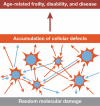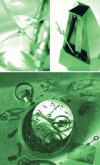Time of our lives. What controls the length of life?
- PMID: 15995661
- PMCID: PMC1369269
- DOI: 10.1038/sj.embor.7400419
Time of our lives. What controls the length of life?
Abstract
What controls the length of life?
Figures





References
-
- Berry RJ, Bronson FH (1992) Life history and bioeconomy of the house mouse. Biol Rev Camb Philos Soc 67: 519–550 - PubMed
-
- Brierley EJ, Johnson MA, Lightowlers RN, James OF, Turnbull DM (1998) Role of mitochondrial DNA mutations in human aging: implications for the central nervous system and muscle. Ann Neurol 43: 217–223 - PubMed
-
- Carrard G, Bulteau AL, Petropoulos I, Friguet B (2002) Impairment of proteasome structure and function in aging. Int J Biochem Cell Biol 34: 1461–1474 - PubMed
-
- Cottrell DA, Blakely EL, Johnson MA, Ince PG, Borthwick GM, Turnbull DM (2001) Cytochrome c oxidase deficient cells accumulate in the hippocampus and choroid plexus with age. Neurobiol Aging 22: 265–272 - PubMed
-
- Cournil A, Kirkwood TB (2001) If you would live long, choose your parents well. Trends Genet 17: 233–235 - PubMed
MeSH terms
LinkOut - more resources
Full Text Sources

